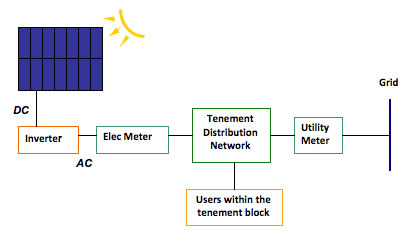The most important factors to consider when choosing suitable solar panels are the expected annual output and the price. Other factors to consider include the size, weight and expected lifespan. The output per square metre was also used to assess the maximum possible output capacity that could be achieved from the defined rooftop area.
The first factor to assess was the predicted annual output. This was done over a range of available solar panels, both from the Merit Database and also from manufacturer’s datasheet information. The assessment was also conducted over a range of tilt angles from 30-50° using climatic data for Glasgow for a typical year.
Some of the more significant results at the constant angle of 40° are shown in Table 1.
Solar Panel |
Surface Area (m²) |
Output (kWh) |
Output (kWh/m²) |
Tilt Angle |
100W Poly |
0.87 |
91 |
104 |
40 |
130W Mono |
1.12 |
136 |
121 |
40 |
130W Poly MIT |
1.01 |
140 |
139 |
40 |
167W poly |
1.31 |
182 |
139 |
40 |
220W HIT |
1.26 |
248 |
197 |
40 |
Table 1 – Solar panel assessment
The 220W HIT (Heterojunction with Intrinsic Thin layer) is evidently the most promising Solar panel with regards to output per square metre. This is one of the newer panels on the market that was launched at the end of 2009. Since this installation would be looking for a maximum yield from a relatively small area, this was the panel that was chosen.
The panels would be retrofitted to the existing roof, requiring direct mounting as the tilt angle is already suitable. The units would require an inverter to convert the generated DC power to the AC power required for grid connection. Meters would also be required to track the energy usage. The expected configuration is shown in Figure 1.

Figure 1 – PV panel connection configuration